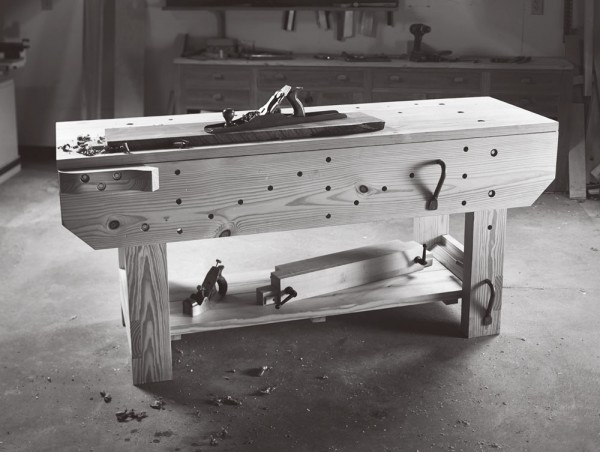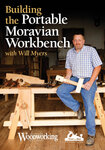We may receive a commission when you use our affiliate links. However, this does not impact our recommendations.
For the last month, I’ve been revising and expanding my first book “Workbenches: From Design & Theory to Construction & Use” for F+W Media. The revised book is scheduled to be out by the end of 2015 and printed in the United States.
I started writing that book in 2005, and a lot has changed in the last 10 years – not in workbench design, but in workholding. Plus, after teaching 15 or so classes on building workbenches (and building another dozen benches myself), I have learned a few things about bench building that have made my life easier.
Oh, and there are a few small errors in the original edition, including one line that people give me inordinate amounts of crap for. I wrote that I added a coat of wax to a benchtop, and then in a later photo caption discuss how that’s stupid for handwork. So I gave bad advice and then I contradicted myself. Sigh.
So I’ve been nipping and tucking the text throughout the entire book. Most of my edits are to reflect changes in what’s available. When I wrote that book, there weren’t any commercial benches that I would buy, there weren’t any manufactured holdfasts that I’d buy and wood vise screws were extremely difficult to find. Today we have an almost-embarrassing array of benches and accessories to choose from.
It’s weird revising your own work. It’s like having a conversation with a younger version of yourself. As I make small changes I mutter to myself: “Yeah, you’re right. But you could have said it in a nicer way.” Good thing I work alone.
I also decided to add two benches to the book.
In the original edition I show how to build an English bench and a French bench, both from construction lumber. They are great benches, and are still in daily service today. But after much thought, I decided to add plans for a knockdown English bench and a no-compromises French bench with all the crazy sliding-dovetail joinery.
As I sat down to write these chapters, I didn’t think I had anything more to say about workbenches. About 10,000 words later, I proved myself wrong.
I’ll have more details on the revised edition as they are available.
— Christopher Schwarz
If you are interested in bench building, check out Will Myers’ new DVD “Building the Portable Moravian Workbench.” It’s a great workbench – I’ve gotten to see it in person – and Will is a great woodworker.
Here are some supplies and tools we find essential in our everyday work around the shop. We may receive a commission from sales referred by our links; however, we have carefully selected these products for their usefulness and quality.











Hi there Chris. I have really enjoyed your original edition, now on my third re-read. Slow at absorption I guess. It is easier to grasp the need for various bench capacities after working at wood for a bit and as I am just getting back to woodworking after decades, I see what features can offer in usefulness.
I am curious. There are now interesting leg vise options from folks like Lee Valley with their scissor style leg vise, but could one also use a twin-screw vise vertically so you could clamp along the vertical edge as with a leg vise? In the case of Lee Valley’s products, the twin-screw is significantly less expensive than the scissor units – a bit before than half the price. What would be the drawbacks?
Chris: I have a small shop and plan to build a Roubo split top bench. I have a friend who runs a tree service and uses a bandsaw mill to cut up the felled trees. That is sort of a hobby for him. I have some White Oak that is nominally 6 inches wide by 2 inches thick around 6 foot in length. My shop is only large enough for a bench that would be 5 to 5.5 feet long. I also have nominal 4 by 4 White Oak for legs. I am going to do your Ikea bench base with a split Roubo top. I need it break it down for an upcoming move. My question is this: my friend now has solid 4 inch thick 14 to 16 inch wide and about 12 foot long heart pine. I am thinking of going with the heart pine for the split top sections. Small shop, benchtop joiner, too much joining for laminating an Oak top. Should I stick with Oak and do the laminate or go solid with the Heart Pine. I will probably put a temporary top on and give the pine at least a year to dry. That begs the question about drying time for heart pine as well.
Missed you at the Birmingham Woodworkers Guild the last couple of visits. Too much work. I have your second book on Benches and am now locked on the “horns of a dilemma”. Also, note, I probably would only have enough White Oak to make the top 2.5 inches thick. So 4 inches Pine or 2.5 inch laminated Oak. I am inclined to go with the pine. I get a great price and solid is solid.
I have a question about an old vise screw I picked up for my leg vise. The seller claimed it was an 18th century piece of hardware, and it has an unusual garter. The garter is metal like the screw and is permanently encircled around the screw just past the hub. It’s also slightly domed on the backside (convex towards the threads). The hole in the garter through which the screw passes is elongated by about ½”. There’s also maybe ⅜” of play between the two, along the axis of the screw. This makes it seem like it would not function well as a garter, leaving the chop in place as the screw is backed out from clamping and allowing the chop to shift in the elongated hole. Have you (or any other readers) seen this before? And if so, any tips on installing it so that the garter moves the chop in tandem with the screw?
Thanks and can’t wait for the new edition.
Hi Chris, I am building a roubo bench like your cherry slab topped beauty. I have old 6×6 beams cut from a 100 year oak 10 years ago on the family farm. The beams were stored outside and will take some work to get down to the good wood.
Anyway my question is; what would you change on that bench if you could do it again? Any new lessons learned or insights I should keep in mind during the build? Any potential pit falls?
Thanks and love the blog.
When can we pre-order?!?!?
That’s excellent news, Chris! I’ve read the original book several times, but have always utilized a library copy. I received the second book for Christmas and was planning to purchase the first one, but now I will wait. Sounds like there will be some great additional content. I have a pile of southern yellow pine 2 x 12 x 16 boards in my basement workshop that will become a new workbench this summer, and I suppose any new material in the revised book will be inspiration for a future workbench!
Thanks again. Matt